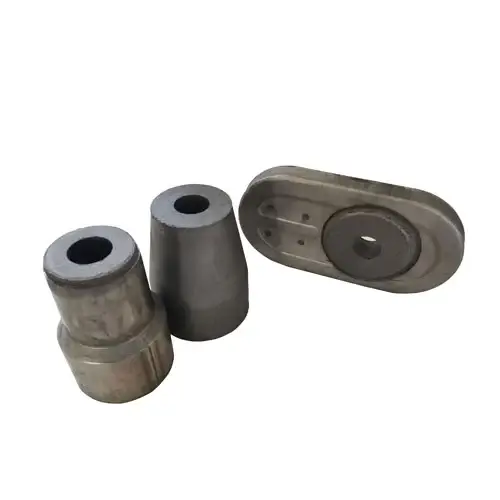Tundish nozzle plays a very important role in ladle steel making. This article introduces how to make tundish nozzle and the types of tundish nozzle clogging. On the other hand, it is also possible to understand the types and differences of refractory nozzles.
Tundish nozzle manufacturing method, relates to a production method of a molten steel continuous casting article and aims to provide a method for manufacturing a tundish nozzle which is low in thermal shock and crack ratio and relatively long in service life.
The tundish nozzle manufacturing method comprises the following steps:
(1)manufacturing zirconia cores, wherein the density of the manufactured zirconia cores is 5.58 to 5.62g/cm<3>, the apparent porosity is smaller than 3.8 percent, and the outer diameter is A;
(2)manufacturing prestressing rings, wherein the inner diameter of the manufactured prestressing rings is 0.008A to 0.01A smaller than the outer diameter of the zirconia cores;
(3)sleeving the rings, i.e. after heating a plurality of prestressing rings to the temperature of 700+/-10 DEG C, sleeving the prestressing rings on the zirconia cores, wherein the two ends of the zirconia cores must be provided with the prestressing rings, and naturally cooling to form the zirconia cores on which the prestressing rings are sleeved;
(4)integrally molding, i.e. sleeving the zirconia cores on which the prestressing rings are sleeved in a nozzle molding die, pouring a pre-mixed nozzle shell material into the molding die, pressing to mold, and finally, de-molding to obtain the tundish nozzle.

During molten steel continuous casting, molten steel flows into crystallizer by middle water containing opening, is cooled to steel billet and is pulled machine and pulls away, and molten steel constantly flows into crystallizer by middle water containing opening simultaneously.In the process, the size of the internal diameter of middle water containing opening determines the speed that molten steel flows into crystallizer, in order to keep conticaster continuous operation, require that the internal diameter of middle water containing opening core (usual more than 6 hours) within the time long as far as possible remains unchanged substantially, that is, mouth of a river core is needed to have the performance of anti-molten steel erosion.On the other hand, when molten steel is by middle water containing opening core, requires that it can not burst, that is, need mouth of a river core to have very high thermal shock drag.
Currently available technology, middle water containing opening core zirconia material is made.If desired the erosion property of resistance to molten steel improving mouth of a river zirconia core just must improve its bulk density, reduces the porosity.But then, after the porosity of mouth of a river core reduces, the expansion owing to not having enough space to produce during expanded by heating, causes the thermal shock drag of mouth of a river core to decline, that is, the erosion property of resistance to molten steel of mouth of a river zirconia core is conflicting performance requirement with thermal shock resistance.
In casting steel in a continuous casting machine it is essential for achieving an acceptable result that the pouring stream between the tundish and the mould is substantially kept constant.
Types OF Tundish Nozzle Clogs
Tundish nozzle clogging problems take many different forms, and can occur anywhere inside the nozzle, including the upper well, bore, and ports. They are classified here into four different types according to their formation mechanism: the transport of oxides present in the steel to the nozzle wall, air aspiration into the nozzle, chemical reaction between the nozzle refractory and the steel, and steel solidified in the nozzle. In practice, a given nozzle clog is often a combination of two or more of these types, and its exact cause can be difficult to identify.
in a summary, you have an in-depth understanding of tundish nozzle, types and differences, welcome to visit our factory to view tundish nozzle and other refractory nozzle.
FAQ:
What is a tundish nozzle?
Tundish Nozzles are an integral part of Continuous Steel Casting process. These products are instrumental in controlling the flow of Molten Steel from Tundish to Continuous Casting.
What are the uses of tundish?
What does a tundish do? A tundish is installed to prevent cross-contamination between an overflow pipe and a drain pipe. Unsanitary water from the drain pipe could theoretically enter the system if a tundish is not installed to block this.
What is tundish nozzle made of?
Tundish Nozzles usually comprise a zirconia inner nozzle (often referred to as a “zirconia insert”) with a lower grade outer body such as Alumina, Zircon or Bauxite.
Why is my tundish nozzle clogging?
The cause of the clogging is related to a combination of operating criteria including ladle slag practice, tundish refractory, deoxidation methodology and temperature.
What are the different types of nozzle?
Different types of spray nozzles
Flat Fan Nozzles.
Hollow Cone Nozzles.
Full Cone Nozzles.
Solid Stream Nozzles.


